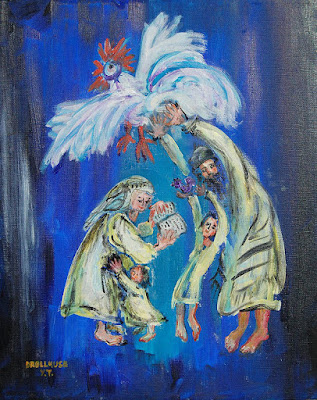Guilt. Shame. Atonement: Along with everyone else in the Albuquerque, New Mexico, and world film communities, and along with everyone else who has heard the news, Abq Jew mourns the sudden, tragic, untimely death of cinematographer Halyna Hutchins on a movie set in Santa Fe.
 |
| People hold candles as they attend a vigil held to honor cinematographer Halyna Hutchins at Albuquerque Civic Plaza on October 23 in Albuquerque, New Mexico. CNN |
While it is true that others have died from gunshots with much less attention, the death of Ms Hutchins has struck a deep chord with Abq Jew - a father of someone (Dov Yellin the Video Editor) of Ms Hutchins' generation who also works in the film industry. And the father of a daughter, about whom he worries all the time.
And, Abq Jew is sure, Ms Hutchins' death has struck a deep chord with many of you, his loyal readers.
It is impossible for Abq Jew (or anyone, at this time) to determine the legal and moral culpability (if any) of anyone involved in this tragedy - the armorer, the assistant director, or the actor.
But Abq Jew is sure that all of them - and, perhaps others - are ashamed of what happened, and are looking for a place where they can hide.
Maybe forever.
In the Old Days, there was a place where those involved in an accidental death could run from the avenger of blood - the victim's relative, who could otherwise pursue the killer and kill him - with impunity. That place was a city of refuge, where the killer was safe from the avenger's knife.
These days - the avenger is more likely to attack the killer with a lawyer than a knife. But the principle remains the same.
- Complete innocence, for which no further action was necessary.
- Negligence, which required exile to a city of refuge.
This situation arises when someone is killed as a result of legal activity, which the perpetrator was not required to perform. - Severe carelessness, for which exile is insufficient.
This situation arises when someone is accidentally killed as a result of illegal activity by the perpetrator; for example, this situation arises if a shop owner fails to maintain their property, and it collapses and kills a legitimate customer. - Murder, which was subject to the death penalty.
The cities of refuge were only for those who killed accidentally, not knowing the consequences of their actions. If the person killed out of gross negligence—for example, knocking down a wall in a public area without looking whether anyone was there—the sin is too severe to be atoned for by exile, and the cities of refuge don’t serve as a haven for the killer.Conversely, if a person tore down a wall in a private area that people never frequent, and a stone fell and killed someone who happened to be there by a fluke, the death is seen as beyond his control, and the accidental killer is not exiled, nor may the blood redeemer kill him.Although the main purpose of cities of refuge was to protect one who accidentally killed, in practice, murderers who killed intentionally went there too.
When a person arrived at a city of refuge, the court sent messengers to bring him in for a hearing. These messengers also acted as bodyguards, to protect him from blood avengers.
If it was decided that he’d murdered intentionally, he would be judged accordingly; but if the judges determined that it was an unintentional killing, the messengers would return him to the city of refuge.
In his Guide for the Perplexed, Rambam writes that the national mourning that took place at the death of the high priest distracted the mourners of the family member who was killed by the refugee.
Another explanation is that it was a punishment for the high priest, who “should have prayed that no such accident would happen to the Jews in his lifetime.”
A third explanation is that the high priest causes the Divine Presence to rest upon Israel and thus prolong their lives, whereas the murderer causes the Divine Presence to withdraw from Israel and thus shorten their lives, so he is not worthy of standing before the kohen gadol.
So what you had was - a large number of people, all the killer's family and friends, and even the killer himself, praying for the death of the high priest and the killer's release. Wikipedia adds:
As killers were freed from the city of refuge upon the death of the High Priest, the Mishnah states that the high priest's mother would traditionally supply them with clothing and food, so that they would not wish for the death of her son.
The Talmud argues that the death of the high priest formed an atonement, as the death of pious individuals counted as an atonement.
Maimonides argued that the death of the high priest was simply an event so upsetting to the Israelites that they dropped all thoughts of vengeance.
Chabad tells this story:
An old woman walks along the road, carrying heavy parcels and leading a donkey laden with pots of savory food. She is on her way to a city where she’ll dispense the food to the locals.This old woman is none other than the mother of the high priest, and she’s walking to a city of refuge, a city to which a person flees if he’s killed someone.Why is the mother of the high priest bringing food to these murderers?This was the mother of the high priest, who went around to the cities of refuge distributing food and clothing to the refugees so that they wouldn’t pray for the death of her son, which would free them from their exile.
Some commentators say that she hoped to spoil them so much that not only wouldn’t they pray for his death, they would even pray for him to have a long life.
According to classical rabbinical authorities, the cities of refuge were not places of protection, but places where atonement was made; Philo explained this principle as being based on the theory that an innocent man would never be chosen by God as the instrument of another man's death, and therefore those claiming refuge at these cities must have committed some sin before they had killed, for which their exile acts as an atonement.
We do not live in the ancient world. There are no cities of refuge for those who kill accidentally. Avengers of blood generally attack with lawyers, not knives.Where does this leave us?









No comments:
Post a Comment